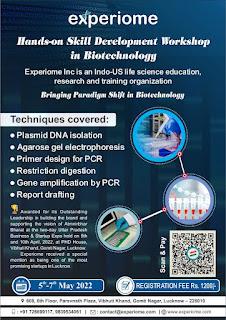Best Biotech Training in Uttar Pradesh | Experiome
What is Genome Annotation?
The process of identifying the locations of genes and all of the coding sections in a
genome, as well as establishing what those genes perform, is known as genome
annotation. It's required because DNA sequencing generates sequences with
uncertain functions. Genome annotation has progressed over the last three decades
from computational annotation of long protein-coding genes on single genomes
and experimental annotation of short regulatory elements on a small number of
them to population annotation of single nucleotides on thousands of individual
genomes. Biotech Course This improved precision and inclusivity of genome annotations (from
genotypes to phenotypes) is resulting in more precise insights into the biology of
species, communities, and people. Genome annotation includes three major steps:
1. Identifying regions of the genome that do not encode proteins;
2. Identifying genome fundamentals, a process known as gene prediction; and
3. Identifying these elements' organic information
Annotation files include information about the genomic sequence. FASTA, GFF3,
and GENBANK are few examples of file formats. There are various file formats
for representing sequence, structure, and pathway information relating to genes and
proteins, and internet databases provide the ability to select and download certain
files.
Genome annotation is of two types structural annotation that includes identification
of genomic elements while the assignment of function to structural elements is
known as functional annotation.
The genes or proteins that may be recruited by a certain genomic sequence can be
predicted using gene annotation algorithms. These new genes or proteins can be
functionally annotated by comparing their sequences to well-experimentally
confirmed sequences in databases.
Now that the genome sequences of over a thousand human persons (The 100,000
Genomes Project, UK) and some model organisms are fully complete, genome
annotation remains a key hurdle for scientists exploring the human genome.
Defining the biological "parts list" for the assembly and normal operation of an
organism is sometimes referred to as locating genes and other genetic regulatory
elements. Scientists are currently in the early stages of defining this parts list and
figuring out how all of the pieces "fit together.”

Comments
Post a Comment